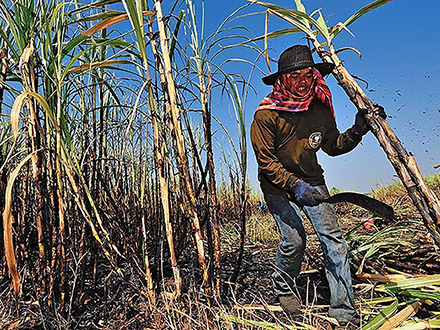By Natalie Rodriguez

Chronic kidney disease of uncertain etiology, or CKDu, reflects a pattern of endemic kidney diseases that cannot be explained by traditional or known risk factors such as diabetes or hypertension. A notable burden of the disease falls on agricultural workers and other manual laborers in Central America and Sri Lanka . Researchers have hypothesized that CKDu is associated with heat stress at work, but the etiologies of CKDu are unclear and may involve a complex interplay of environmental exposures, genetic variation, infections, or lifestyle factors.
Mortality rates from CKDu have increased significantly in Central America since the 1970s, with rates in El Salvador and Nicaragua among the highest in the world. Population-based epidemiological studies in these areas indicate a concentration of disease among male workers in manual occupations, such as sugarcane and other agricultural work, brick manufacturing, mining, and fishing. These individuals are also substantially younger than typical chronic kidney disease patients.
"One of the hypotheses that is widely considered in Central America is that heat stress from strenuous work in a hot climate, perhaps without sufficient breaks or hydration, combine to create a situation where people are prone to getting this this type of kidney disease," said study co-author Daniel Brooks, D.Sc., professor at the Boston University School of Public Health.
With global ambient temperatures and extreme heat events expected to rise, workers in tropical, low-latitude regions of the world could face increasing exposure to occupational heat stress. Previous studies have examined long-term climatic trends at large spatial scales or ambient workplace conditions over short monitoring periods in Central America, but little research has been conducted on the changes at local environments experienced by workers at risk of CKDu.
Local Climate Data Studied
In an attempt to fill this gap, researchers funded by NIEHS assessed climate data at the largest sugar-producing company in Nicaragua, measured changes in temperature across sugar cane harvest seasons, estimated the number of days workers were at risk of heat-related illness, and compared daily maximum temperatures across various sites in Nicaragua.

The team analyzed averaged daily maximum temperatures at seven Automated Surface Observing System (ASOS) Network weather stations in Nicaragua, and at the sugar-producing company, the Ingenio San Antonio (ISA). The researchers noted limitations, including discrepancies in what years and what kind of data each station collected.
After analyzing the data, they found that the average daily maximum temperature at ISA, and notably during the harvesting months of December through May, was higher than in other parts of Nicaragua. The 1974-1975 harvest season saw 17.6% of harvest days with a maximum temperature over 35°C compared to 62.6% during the 1990-1991 harvest season. Between 1991 and 2013, an average of half the harvest days had maximum temperatures over 35°C.
The study reported that on a majority of workdays during the harvest season, workers faced moderate or high risk of heat-related illness based on U.S. Occupational Safety and Health Administration heat index-based risk guidelines .
The researchers noted that although they could not draw any causal conclusions between CKDu and heat stress from this research, they believe these findings add important context to ongoing research on the role of heat stress in the development of CKDu.
"Additional data on incidence of the disease or prevalence at any sort of fine temporal resolution would allow us to look when this disease really became an epidemic and how it correlates with factors like temperature, work practices, or changes in other exposures in the environment," said lead author Zoe Petropoulos, Ph.D. candidate at Boston University School of Public Health.
NIH-wide Efforts Address CKDu
NIEHS and NIH-partnering agencies recognize CKDu as a major public health problem and are funding research to understand how our environment, genetics, and other factors affect risk of kidney diseases. NIEHS joined the National Institute of Diabetes and Digestive and Kidney Diseases (NIDDK) in hosting a workshop in 2018 and an international workshop in 2019 to collaborate with scientific experts from other health organizations and to discuss current knowledge and future research priorities to advance understanding of this disease.
More recently, NIDDK, NIEHS, and the Fogarty International Center are collaborating to launch a landmark research consortium, the Chronic Kidney Disease of UnceRtain Etiology (CKDu) in Agricultural Communities (CURE). Formed to respond to the devastating epidemic of CKDu, the CURE Consortium will consist of a Scientific Data Coordinating Center , Field Epidemiology Sites , a Renal Science Core , and the Human Health Exposure Analysis Resource . The consortium will convene a wide range of expertise and enable discovery science to understand the underlying cause or causes and disease progression of CKDu. In addition, the consortium will aim to identify potential therapeutic targets and public health interventions.

